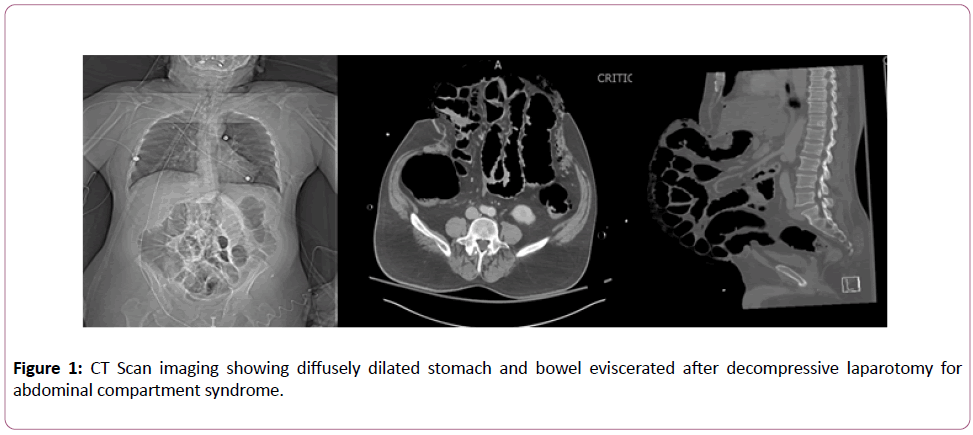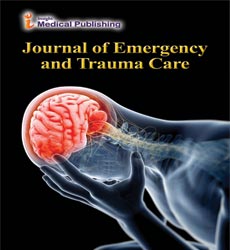Abdominal Compartment Syndrome in the Trauma Patient Who Received Kings Airway in the Pre-Hospital Setting
1Department of Trauma and Surgical Critical Care, Hackensack Meridian Health Center, Hackensack, New Jersey, USA
2Department of Surgery, Hackensack Meridian Health Center, Hackensack, New Jersey, USA
- *Corresponding Author:
- Arthur Berg
Department of Trauma and Surgical Critical Care
Hackensack Meridian Health Center, Hackensack
New Jersey, USA
Tel: +630-606-5554
E-mail: aberg134@gmail.com
Received date: September 11, 2018; Accepted date: September 12, 2018; Published date: September 17, 2016
Citation: Berg A, Bentley E, Kaul S, Sharma J, Dayal S, et al. (2018) Abdominal Compartment Syndrome in the Trauma Patient Who Received Kings Airway in the Pre-Hospital Setting. J Emerg Trauma Care Vol.3 No.2:2.
Abstract
Background: The Kings Laryngeal Tube is a popular prehospital device used in the difficult airway. Since its introduction in 1999, the literature has cited a “first-pass rate” as high as 100% in some studies. Complication rates reported in the literature most cite low morbidity events such as aspiration and mucosal injury. Risk of dislodgement is seldom described in the literature and is likely underreported. Objective: Discuss the unique presentation, diagnosis, and management of a patient who suffered from abdominal compartment syndrome secondary to dislodged Kings LT and severe gastric distention. Case Report: A 60-year-old male presented with multiple traumatic injuries after being thrown several feet by a large SUV. The patient was altered in the field and experiencing significant hematemesis compromising his airway. Initial attempts to intubate the patient were unsuccessful with an ETT however a Kings LT was successfully placed. Ventilation with the supraglottic airway was continued into the trauma bay however his SpO2 never improved beyond 90%. After several minutes, the King’s LT was removed and an ETT was attempted under video assistance, however, this was also unsuccessful. A surgical airway was obtained however the patient still did not improve from a respiratory standpoint. During this series of events, his abdomen was becoming increasingly distended and his chest rise was poor bilaterally. Clinically he demonstrated signs of abdominal compartment syndrome. He underwent emergent decompressive laparotomy at the bedside. His stomach was noted to be severely distended and his small bowel was diffusely dilated as well. The maneuver instantly improved his O2 saturations and normalized his vital signs. Patient was subsequently transferred to OR for application of a temporary closure device and repair of his other injuries. Conclusion: Severe gastric distention and abdominal compartment syndrome secondary to tracheal dislodgement in a King’s Laryngeal Tube is a rare entity that should be considered as one of the potential complications of insertion.
Abstract
Background: The Kings Laryngeal Tube is a popular prehospital device used in the difficult airway. Since its introduction in 1999, the literature has cited a “first-pass rate†as high as 100% in some studies. Complication rates reported in the literature most cite low morbidity events such as aspiration and mucosal injury. Risk of dislodgement is seldom described in the literature and is likely underreported.
Objective: Discuss the unique presentation, diagnosis, and management of a patient who suffered from abdominal compartment syndrome secondary to dislodged Kings LT and severe gastric distention.
Case Report: A 60-year-old male presented with multiple traumatic injuries after being thrown several feet by a large SUV. The patient was altered in the field and experiencing significant hematemesis compromising his airway. Initial attempts to intubate the patient were unsuccessful with an ETT however a Kings LT was successfully placed. Ventilation with the supraglottic airway was continued into the trauma bay however his SpO2 never improved beyond 90%. After several minutes, the King’s LT was removed and an ETT was attempted under video assistance, however, this was also unsuccessful. A surgical airway was obtained however the patient still did not improve from a respiratory standpoint. During this series of events, his abdomen was becoming increasingly distended and his chest rise was poor bilaterally. Clinically he demonstrated signs of abdominal compartment syndrome. He underwent emergent decompressive laparotomy at the bedside. His stomach was noted to be severely distended and his small bowel was diffusely dilated as well. The maneuver instantly improved his O2 saturations and normalized his vital signs. Patient was subsequently transferred to OR for application of a temporary closure device and repair of his other injuries.
Conclusion: Severe gastric distention and abdominal compartment syndrome secondary to tracheal dislodgement in a King’s Laryngeal Tube is a rare entity that should be considered as one of the potential complications of insertion.
Keywords
Pre-hospital device; Aspiration; Gastric distention; Compartment syndrome
Introduction
In the pre-hospital setting, airway management is a vital part of EMS practice and critical for the patient’s care and survival. There are a wide variety of techniques to secure a patient’s airway, ranging from the use of facial mask devices to more interventional methods such as endotracheal intubation. In the difficult airway, a supraglottic airway known as the King Laryngeal Tube has garnered a lot of attention given its ease of placement and high success rate. Since its introduction in 1999, some studies have reported a “first-pass rate” as high as 100% [1]. Complications reported in the literature are rare and mostly cite low morbidity events such as aspiration and mucosal injury [2,3]. We discuss a case of abdominal compartment syndrome secondary to tracheal misplacement of the Kings LT Tube in the pre-hospital setting.
Case Report
Our patient is a 60-year-old Male brought in via ALS with ccollar after being thrown several feet by a large SUV. EMS reported that patient was altered in the field and experiencing significant hematemesis that compromised his airway necessitating intubation. Initial attempts were made with an ETT however were unsuccessful, and subsequently a King LT was placed instead. Upon initial evaluation in our trauma bay, he had significant facial trauma, active hematemesis, and abdominal distention. Ventilation with the King LT was continued for some time, however his SpO2 never improved above 90%. ETT intubation was attempted with Glidescope however was unsuccessful given his injuries. OGT insertion was also attempted unsuccessfully.
Upon obtaining a successful airway via tracheotomy, patient’s saturations did not improve despite positive color change on capnography and breath sounds heard on both sides. Given extent of injuries, decision was made to place bilateral chest tubes, however saturations continued to be unsatisfactory, ranging from 60-70% and he was becoming hemodynamically unstable. At this time, the patient’s abdominal distention was noted to be much worse, and his chest rise was poor bilaterally. Clinically, he demonstrated classic signs of abdominal compartment syndrome. He underwent emergent decompressive laparotomy at the bedside. His stomach was noted to be severely distended and his small bowel was diffusely dilated as well. The maneuver instantly improved his O2 saturations and normalized his vital signs. Afterward a successful OGT was placed and extravasation of air and gastric contents was aspirated. A CT scan was performed prior to the operating room and is shown below (Figure 1). Patient was subsequently transferred to OR for application temporary closure device and repair of his other injuries.
Discussion
The literature on complications from supraglottic airways such as the Kings LT Tube includes aspiration of gastric contents, compression of adjacent vascular structure, local trauma, nerve injury, and most commonly mucosal injury [3]. Misplacement leading to abdominal compartment syndrome is not described. Given the ease of insertion and effectiveness compared to other forms of supra-glottic airways, the King LT offers an advantage in the pre-hospital setting especially for inexperienced personnel. However, the risk of tracheal misplacement is likely underreported [4]. This is likely for two reasons. The amount of time a supraglottic airway is in place may be appropriately positioned initially, but its long-term efficacy is difficult to measure because it’s removed shortly after arriving to the hospital. Secondly, its anatomic placement is not routinely confirmed by radiologic imaging. The importance of this case illustrates the need for a high clinical index of suspicion in patients who are ventilating poorly with a supra-glottic airway. It also demonstrates the need for additional methods for confirming placement of these prehospital devices. We presented a case of a patient who had a likely misplaced King LT airway for a significant amount of time to induce gastric distention and subsequently lead to abdominal compartment syndrome.
Abdominal compartment syndrome caused by gastric dilation alone is in itself a rare entity [5,6]. The incidence of ACS in the trauma patient is 5%, most commonly from intra abdominal hemorrhage or severe intra-peritoneal edema [6]. A sustained elevation of intra-abdominal pressures affects preload, afterload, renal perfusion, as well as pulmonary kinetics [7]. Acute severe gastric distention has been described in patients with gastric outlet obstruction, aerophagia, eating disorders, muscular dystrophy, and gastroparesis [8]. There are currently no cases in the literature that describe the sequela outlined in our case.
Conclusion
Severe gastric distention and abdominal compartment syndrome secondary to tracheal dislodgement in a King’s Laryngeal Tube is a rare entity that should be considered as one of the potential complications of insertion.
References
- Dodd K, Kornas R, Prekker M, Klein L, Reardon R, et al. (2017) Endotracheal intubation with the king laryngeal tube™ in situ using video laryngoscopy and a bougie: A retrospective case series and cadaveric crossover study. J Emerg Med 52: 403-408.
- Brown S, Cherian V, Greco K, Mets E, Budde A, et al. (2016) an uncommon complication with a supraglottic airway. A & A Case Rep 6: 88-89.
- Subramanian A, Garcia-Marcinkiewicz A, Brown D, Brown M, Diedrich D, et al. (2015). Definitive airway management of patients presenting with a pre-hospital inserted King LT[S]-D™ laryngeal tube airway: A historical cohort study. Can J Anaesth 63: 275-282.
- Driver B, Plummer D, Heegaard W, Reardon R (2016) tracheal malplacement of the King LT airway may be an important cause of prehospital device failure. J Emerg Med 51: 133-e135.
- Luca A, Cirera I, GarcÃÂÂa-Pagán J, Feu F, Pizcueta P, et al. (1993) Hemodynamic effects of acute changes in intra-abdominal pressure in patients with cirrhosis. Gastroenterology 104: 222-227.
- Mahajna A, Mitkal S, Krausz M (2008) Postoperative gastric dilatation causing abdominal compartment syndrome. World J Emerg Surg 3: 7.
- Teplick R (2007) Intra-abdominal pressure measurement and abdominal compartment syndrome: The opinion of the World Society of the Abdominal Compartment Syndrome. Crit Care Med 35: 678-679.
- Spiller R (2006) An unusual cause of abdominal distention. Gut 55: 1759.
Open Access Journals
- Aquaculture & Veterinary Science
- Chemistry & Chemical Sciences
- Clinical Sciences
- Engineering
- General Science
- Genetics & Molecular Biology
- Health Care & Nursing
- Immunology & Microbiology
- Materials Science
- Mathematics & Physics
- Medical Sciences
- Neurology & Psychiatry
- Oncology & Cancer Science
- Pharmaceutical Sciences

